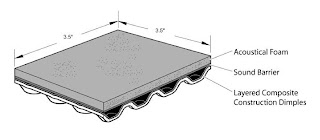Must-Know Basics Of Soundproofing
Have you ever been to a recording studio or a fully
functional comedy club? If yes, you might have noticed the place being devoid
of sound completely. It's important to the establishment there, but
soundproofing is now important to every building. Rabid development has made
our cities and neighborhood loud and noisy. Well, this is where a professional comes
with the finest soundproofing products to keep the noise away from you. We all
have come across soundproofing, but do you know the basics of soundproofing?
Well, in that case, here are some must-knows of soundproofing.
What is soundproofing?
Soundproofing is the method of reducing the ability of sound
to travel. This can be accomplished by reduction and absorption of noise. There
are several methods to approach the process of soundproofing like increasing
the distance between the source and the receiver, using noise barriers, using
damping structures, etc..
Though soundproofing was found to be a common ground earlier
in recording studios and other commercial purposes, now it is common to find
residential soundproofing solutions. Soundproofing can lower down the indirect
sounds like echoes resonances. In a nutshell, soundproofing is a process that
keeps away the unwanted noise and makes the sounds that are needed much
clearer.
Some Common Terms:
When you are dealing with soundproofing solutions, you will
come across some common industry terms. Here is a list of some common terms
which embody the basics of soundproofing.
- Distance: Distance matters a lot when sound is considered. The energy of sound waves decreases as they go ahead. One of the core principles of reducing the noise is by creating a distance between the source and the receiver. The more the distance, the lesser the sound.
- Damping: Damping, as the name suggests, means to reduce the resonance in the room by absorption and reflection. In environments like the recording studio, damping is important to enhance the wanted sounds and decrease the unwanted noises. This results in a better and clearer overall sound output.
- Absorption: Many soundproofing products are designed to absorb the unwanted noise. There are several kinds of absorption material that reduce the noise level by a big margin. The absorbers can be divided into two categories – porous absorbers and resonant absorbers. Absorbing the sound converts the energy into heat energy and hence, reducing the noise.
- Reflection and Diffusion: Reflection of sound waves is important to keep the noise out of the equation. It depends on the dissimilarity of the reflective surface. Diffusion is an extension of reflection. In the case of a hard surface making problematic echoes, a diffuser is brought in to scatter the sound.
These are some common terms you might come across when you
are treading the soundproofing path. Innovations like noise cancellation are
making the process of soundproofing easier. With the growing noise disturbances
around, residential soundproofing has become a common ground. However, much
like any other service, soundproofing should be left to the professionals. They
know the best soundproofing products to be used in the context of a customer's
requirement. The sound is good, but noise isn't.


Comments
Post a Comment